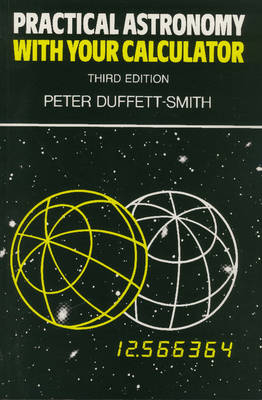
Practical Astronomy with your Calculator
Cambridge University Press (Verlag)
978-0-521-35629-9 (ISBN)
- Titel erscheint in neuer Auflage
- Artikel merken
Practical Astronomy with your Calculator, first published in 1979, has enjoyed immense success. The author's clear and easy to follow routines enable you to solve a variety of practical and recreational problems in astronomy using a scientific calculator. Mathematical complexity is kept firmly in the background, leaving just the elements necessary for swiftly making calculations. The major topics are: time, coordinate systems, the Sun, the planetary system, binary stars, the Moon, and eclipses. In the third edition there are entirely new sections on generalised coordinate transformations, nutrition, aberration, and selenographic coordinates. The calculations for sunrise and moonrise are improved. A larger page size has increased the clarity of the presentation. This handbook is essential for anyone who needs to make astronomical calculations. It will be enjoyed by amateur astronomers and appreciated by students studying introductory astronomy. • Clear presentation • Reliable approximations • Covers orbits, transformations, and general celestial phenomena • Can be used anywhere, worldwide • Routines extensively tested by thousands of readers round the world
Preface to the third edition; About this book and how to use it; Part I. Time: 1. Calendars; 2. The date of Easter; 3. Converting the date to the day number; 4. Julian day numbers; 5. Converting the Julian day number to the calendar date; 6. Finding the day of the week; 7. Converting hours, minutes and seconds to decimal hours; 8. Converting decimal hours to hours, minutes and seconds; 9. Converting the local time to UT; 10. Converting UT to local civil time; 11. Sidereal time (ST); 12. Conversion of UT to GST; 13. Conversion of GST to UT; 14. Local sidereal time (LST); 15. Converting LST to GST; 16. Ephemeris time (ET) and terrestrial dynamic time; Part II. Coordinate Systems: 17. Horizon coordinates; 18. Equatorial coordinates; 19. Ecliptic coordinates; 20. Galactic coordinates; 21. Converting between decimal degrees and degrees, minutes and seconds; 22. Converting between angles expressed in degrees and angles expressed in hours; 23. Converting between one coordinate system and another; 24. Converting between right ascension and hour-angles; 25. Equatorial to horizon coordinate conversion; 26. Horizon to equatorial coordinate conversion; 27. Ecliptic to equatorial coordinate conversion; 28. Equatorial to ecliptic coordinate conversion; 29. Equatorial to galactic coordinate conversion; 30. Galactic to equatorial coordinate conversion; 31. Generalised coordinate transformations; 32. The angle between two celestial objects; 33. Rising and setting; 34. Precession; 35. Nutation; 36. Aberration; 37. Refraction; 38. Geocentric parallax and the figure of the Earth; 39. Calculating corrections for parallax; 40. Heliographic coordinates; 41. Carrington rotation numbers; 42. Selenographic coordinates; 43. Atmospheric extinction; Part III. The Sun: 44. Orbits; 45. The apparent orbit of the Sun; 46. Calculating the position of the Sun; 47. Calculating orbits more precisely; 48. Calculating the Sun's distance and angular size; 49. Sunrise and sunset; 50. Twilight; 51. The equation of time; 52. Solar elongations; Part IV. The Planets, Comets and Binary Stars: 53. The planetary orbits; 54. Calculating the coordinates of a planet; 55. Finding the approximate positions of the planets; 56. Perturbations in a planet's orbit; 57. The distance, light-travel time and angular size of a planet; 58. The phases of the planets; 59. The position-angle of the bright limb; 60. The apparent brightness of a planet; 61. Comets; 62. Parabolic orbits; 63. Binary-star orbits; Part V. The Moon and Eclipses: 64. The Moon's orbit; 65. Calculating the Moon's position; 66. The Moon's hourly motions; 67. The phases of the moon; 68. The position-angle of the Moon's bright limb; 69. The Moon's distance, angular size and horizontal parallax; 70. Eclipses; 72. The 'rules' of eclipses; 73. Calculating a lunar eclipse; 74. Calculating a solar eclipse; 75. The Astronomical calendar; Glossary of terms; Symbols and abbreviations; Index.
| Erscheint lt. Verlag | 2.2.1989 |
|---|---|
| Zusatzinfo | 41 Line drawings, unspecified |
| Verlagsort | Cambridge |
| Sprache | englisch |
| Maße | 152 x 228 mm |
| Gewicht | 460 g |
| Themenwelt | Sachbuch/Ratgeber ► Natur / Technik ► Weltraum / Astronomie |
| ISBN-10 | 0-521-35629-6 / 0521356296 |
| ISBN-13 | 978-0-521-35629-9 / 9780521356299 |
| Zustand | Neuware |
| Haben Sie eine Frage zum Produkt? |
aus dem Bereich


